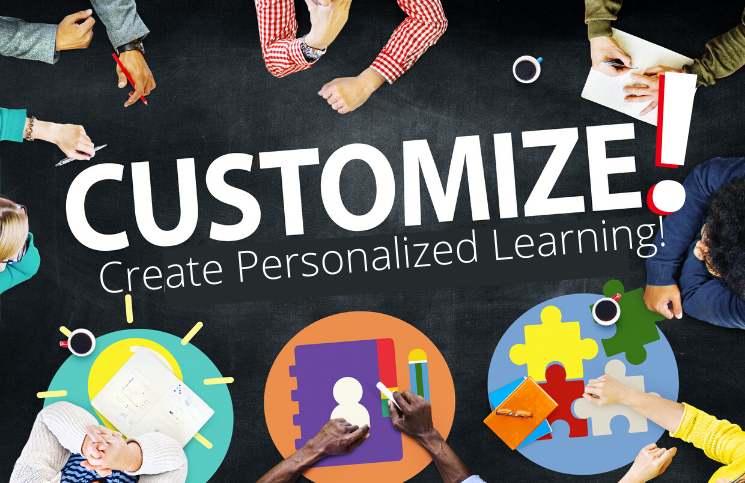The teacher must be sensitive to the student’s strengths and weaknesses.
by Joan Reissman, MCAS Maven
Every educator is familiar with differentiated instruction and blended learning. We are bombarded by multiple options for digital learning. There is a glut of high-quality digital content, but do we know how best to use it to serve the needs of our students and make learning accessible for everyone? As teachers, we want students to be engaged and build foundational skills. One of the best ways to engage students is to deepen differentiated instruction with personalized learning.
What is personalized learning? iNACOL (International Association for K-12 Online Learning) defines personalized learning as…

I see personalized learning as a way to enrich differentiated instruction. We want to give students a voice and tailor learning to individual interests. We might be surprised at how much some students will improve by giving them a voice. But we still have curriculum standards and state and school exams to consider.
Teachers have traditionally aimed for the middle, which left out large segments of students who were either below or above average.
Many teachers have re-structured their methodology through differentiated instruction, in which the teacher designs student learning paths by tailoring lessons to individual needs and learning styles. Learning opportunities are student-centered and students often work in flexible groups.
Personalized learning includes differentiation but goes beyond it. The thought leaders on the subject, Barbara Bray and Kathleen McClasky, emphasize that the key difference is personalization starts with the learner and lets them “actively participate in the design of their learning”. Each student will have an individual plan and will work with the teacher to choose a learning path. The teacher must be sensitive to the student’s strengths and weaknesses, learning style and individual interests. Personalized learning is based on the theory of Universal Design Learning, which is engagement, representation, and action / expression. (Meyer, Rose, & Gordon 2014). The first step is engaging the student in learning a topic by responding to his or her interests. The next step is recognition, which is providing content and learning acquisition in different ways. The last step is giving students a choice in the way they demonstrate what they’ve learned.
The availability of high quality digital content makes this process possible in the real world of crowded classrooms. Digital content is flexible. It can easily be adjusted to a student’s reading level. Some online products include read-aloud options for struggling readers. Students can have a choice. The teacher can start them working in the software and answering certain questions, but extend the learning by asking them to respond in a variety of ways. She may want to make sure they are mastering the content with particular questions, but provide opportunity to demonstrate understanding beyond simple answers to questions. For example, the student could make a video or comic strip with a similar theme. Students could have the option of written responses if they are more comfortable with writing. If students become full partners in the learning process, they will begin to understand how they acquire knowledge.

Just giving students digital content is not enough. The teacher still has to make learning plans. Digital pedagogy should include just as much planning as traditional classroom instruction. Students should have their own voice but the teacher is still responsible for making and following a plan. Before each class she should have looked at what each student did in the previous session and evaluate what needs to be done in the next session. There should be a review of goals and an assessment of progress. It helps to keep a log with short summaries of student activity from the previous sessions and specific goals for the current session. Students can also provide their own evaluations of what they have done and can set their own goals. Teachers should listen closely to what students say about their learning while sharing information with them. Establishing a comfortable climate for sharing information will help both teacher and student. The student will stay motivated and sustain interest in progress. If a student is not succeeding, the teacher should try to assess what is holding the student back. Is the student not understanding the topic or is there a weakness in foundation skills? The information sharing session is a venue for developing an action plan together.
Formative assessments should not use the grade as the main point. Assessments should probe what students have learned and what is holding them back. What do they need to do in order to move forward? Grading period assessments that are just about the grade produce more stress. Students who have a history of weak performance may shut down and not even try because they are convinced they can’t succeed. It’s more constructive to let students work at a pace that is best for them. If they need more time to master the material it’s better to give them the time than to undermine future learning by destroying their confidence.
Students should have the opportunity to share knowledge with their peers. A class webpage can allow sharing. One example is making a rap song that demonstrates an understanding of math concepts. This video, ‘Math Rap – Rules of Exponents’ is one approach. The students created a rap that demonstrates their understanding of exponent laws. Although a project like this takes a lot of work, it could be part of a summative assessment. If students have a chance to demonstrate knowledge in different ways, the possibilities are endless and so is their engagement.
Balancing the demands of engaging students and meeting academic requirements is challenging, but there are ways to meet this challenge. Taking differentiation to the next level can lead to both higher student engagement and better performance on mandated assessments. Contrary to Frost’s wistful lament, one traveler can travel both roads.
Joan Reissman, the MCAS Maven, has been advising students and teachers on learning strategies since 2000.





